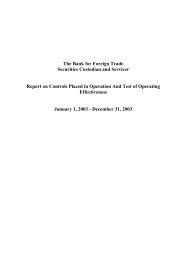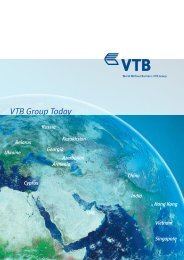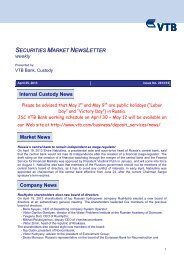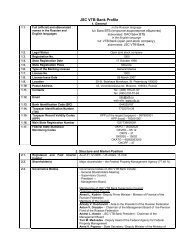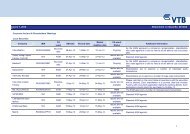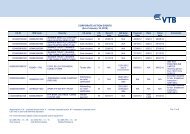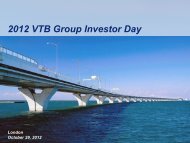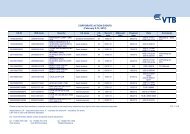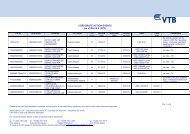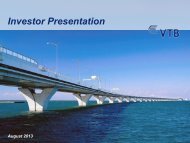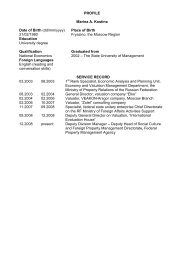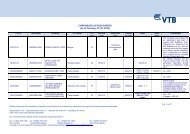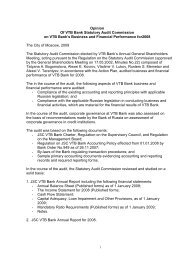Annual report 2011 - VTB
Annual report 2011 - VTB
Annual report 2011 - VTB
- No tags were found...
You also want an ePaper? Increase the reach of your titles
YUMPU automatically turns print PDFs into web optimized ePapers that Google loves.
<strong>VTB</strong> BankNotes to the Consolidated Financial Statements – 31 December <strong>2011</strong> and 2010(in billions of Russian Roubles)5. Summary of Principal Accounting Policies (continued)Investment propertyInvestment property is land or building or a part of building held to earn rental income or for capital appreciation andwhich is not used by the Group or held for the sale in the ordinary course of business. Property that is being constructedor developed or redeveloped for future use as investment property is also classified as investment property.Investment property is initially recognized at cost, including transaction costs, and subsequently remeasured at fair valuereflecting market conditions at the end of the <strong>report</strong>ing period. Fair value of the Group’s investment property is determinedon the base of various sources including <strong>report</strong>s of independent appraisers, who hold a recognized and relevantprofessional qualification and who have recent experience in valuation of property of similar location and category.Investment property that is being redeveloped for continuing use as investment property or for which the market hasbecome less active continues to be measured at fair value. Earned rental income is recorded in the income statementwithin income arising from non-banking activities. Gains and losses resulting from changes in the fair value ofinvestment property are recorded in the income statement and presented within income or expense arising from nonbankingactivities.Subsequent expenditure is capitalized only when it is probable that future economic benefits associated with it willflow to the Group and the cost can be measured reliably. All other repairs and maintenance costs are expensed whenincurred. If an investment property becomes owner-occupied, it is reclassified to premises and equipment, and itscarrying amount at the date of reclassification becomes its deemed cost to be subsequently depreciated.Premises and equipmentPremises and equipment are stated at revalued amounts and cost, respectively, less accumulated depreciation andallowance for impairment where required. Land is stated at revalued amounts. Land has indefinite term of usage and,therefore, is not depreciable. Where the carrying amount of an asset is greater than its estimated recoverableamount, it is written down to its recoverable amount and the difference is recognized in the income statement. Theestimated recoverable amount is the higher of an asset’s fair value less costs to sell and its value in use.Land, premises and equipment of acquired subsidiaries are initially recorded in the statement of financial position attheir estimated fair value at the date of acquisition. No accumulated depreciation on the premises and equipmentacquired in the business combinations is presented in the financial statements on the date of acquisition.Land and premises of the Group are subject to revaluation on a regular basis, approximately every three to five years.The frequency of revaluation depends upon the change in the fair values. When the fair value of a revalued assetdiffers materially from its carrying amount further revaluation is performed. The revaluation is applied simultaneouslyto the whole class of property to avoid selective revaluation.Any revaluation surplus is credited to the other comprehensive income and increases land and premises revaluationreserve which is a separate equity section of the statement of financial position, except to the extent that it reversesan impairment of the same asset previously recognized in the income statement, in which case the increase isrecognized in the income statement. A revaluation deficit is recognized in the income statement, except for the deficitdirectly offsetting a previous surplus on the same asset is directly offset against the surplus in the asset revaluationreserve for land and premises.The land and premises revaluation reserve included in equity is transferred directly to retained earnings when thesurplus is realized, i.e. on the retirement or disposal of the asset or as the asset is used by the Group; in the lattercase, the amount of the surplus realized is the difference between depreciation based on the revalued carryingamount of the asset and depreciation based on the asset’s original cost.Land and premises were revalued to market value at 31 December 2009. The revaluation was performed based onthe <strong>report</strong>s of independent appraisers, who hold a recognized and relevant professional qualification and who haverecent experience in valuation of assets of similar location and category. As at 31 December <strong>2011</strong> and 2010 theGroup has not performed revaluation of land and premises as the fair value of these assets did not differ materiallyfrom their carrying amounts.Construction in progress is carried at cost less allowance for impairment, if any. Upon completion, assets aretransferred to premises and equipment at their carrying value. Construction in progress is not depreciated until theasset is available for use.If impaired, land, premises and equipment are written down to the higher of their value in use and fair value less coststo sell.The decrease in carrying amount is charged to income statement to the extent it exceeds the previous revaluationsurplus in equity. An impairment loss recognized for an asset in prior years is reversed if there has been a change inthe estimates used to determine the asset’s value in use or fair value less costs to sell.20



